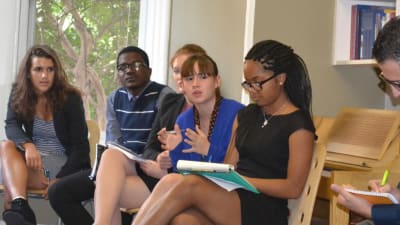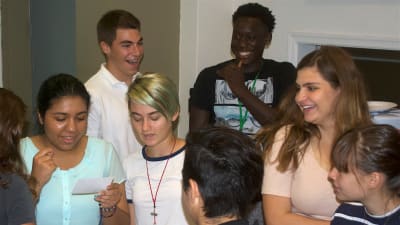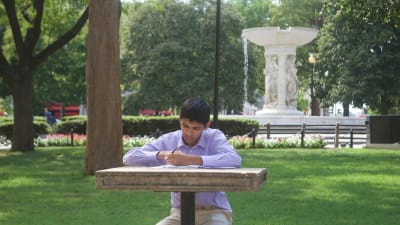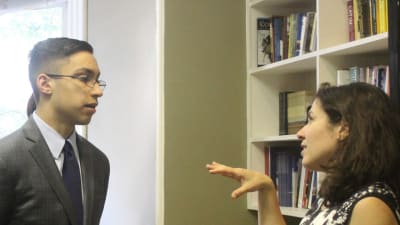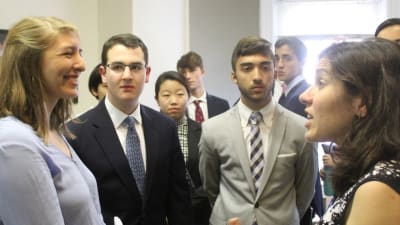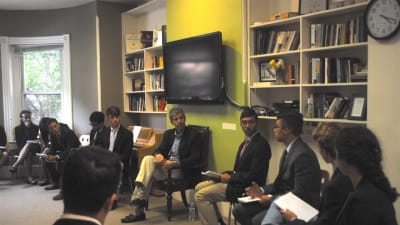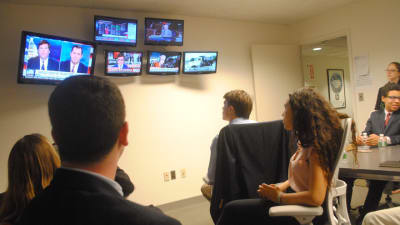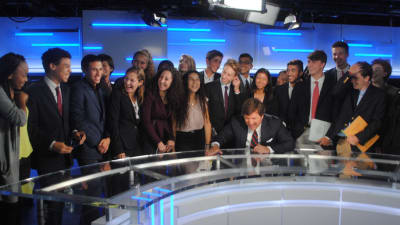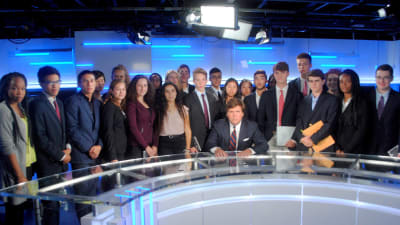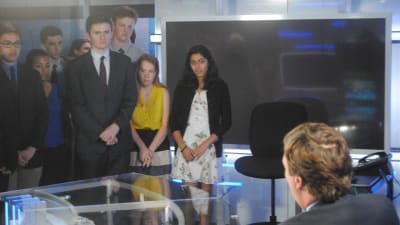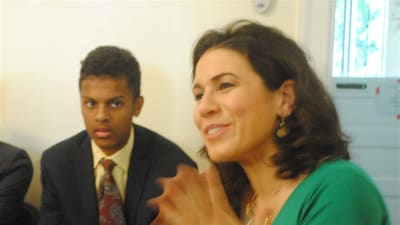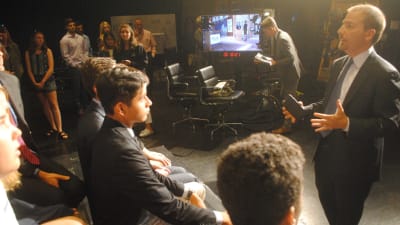Media bias; media literacy
What is truth? It used to be a question for philosophy class. Today, we ask it every time we consume the news. And our Summer 2017 cohort asked it many times this past week during our case study on media literacy. Along the way, they met with two respected newspaper journalists and two of the most powerful TV news hosts in the business.
We began with two exercises designed to help students understand the challenge of modern news production and consumption.
First, after asking each student to write down the five news sources she or he used most, we asked all students to arrange those sources on a matrix. On the “x axis” of that matrix was the liberal-conservative spectrum; on the y-axis how reliable each source was. The results were fascinating and showed both assumptions and blind spots in our group’s news consumption.
Second, we showed the students an unfiltered 20-minute C-SPAN clip of a news event developing in real time. (In this case, the altercation between Senator Elizabeth Warren and Senator Mitch McConnell during the Jeff Sessions confirmation debate.) In groups of four and without doing any research, we asked them to craft a headline and “lede” that best described the events. The goal: be as accurate as possible, while remembering the competitive nature of the news environment. The exercise helped students realize the difficulty in choosing the best words to describe events. (We then showed headlines and ledes from a variety of media outlets, which made for many provocative comparisons!) Both exercises helped create many questions for our guest experts.
The next morning, we welcomed two-time Pulitzer Prize-winning journalist Eric Schmitt. Among other distinctions, Schmitt was the New York Times‘ main contact for WikiLeaks founder Julian Assange, and Schmitt has ample experience wrestling with the ethical issues our case study raised. The students heard several intense stories, his take on the current media landscape, and his advice for news readers in the “fake news” era.
That night, we went to DC’s Fox News headquarters to see a live taping of Tucker Carlson Tonight. One of the only media personalities to work for all three of the major cable news networks, Carlson recently took over the 9pm weeknight time slot from Megyn Kelly when she left for NBC earlier this year. After a tour of the headquarters (and an initial high-energy meeting with Carlson), the students rotated through the on-air studio four at a time–one group per segment–watching Carlson interact with several guests–including Newt Gingrich and Charles Krauthammer, both in-studio–about the day’s top news. After the taping, Carlson and his assistant invited all the students to the anchor desk, where we asked about his show’s audience, his Iraq War pivot, and other topics.
Friday morning brought noted Washington Post journalist Karoun Demirjian to our Capitol Hill residence. Demirjian, who is frequently on the front page of the paper (here is her most recent effort) and often on cable news (she had just come from a CNN interview), spent nearly 90 minutes answering questions about her own journalistic ethos, the newspaper industry, and how her background intersects with her objectivity.
Friday afternoon brought a trip to the Newseum, where students saw pieces of the Berlin Wall and World Trade Center, the famous Pulitzer Prize-winning photo exhibit, and Guardian reporter Ben Jacobs’ glasses, which Montana Congressman Greg Gianforte smashed in a colorful incident last month.
Sunday morning we rose early for a live taping of NBC’s venerable “Meet the Press.” After interviewing the author Malcolm Gladwell and Health and Human Services Secretary Tom Price, and hosting a roundtable discussion between the BBC’s Katty Kay, the Washington Post’s Eugene Robinson, conservative commentator Hugh Hewitt, and NBC reporter Kasie Hunt, Todd took a few moments to meet with students, answer a question, and accept an SEGL mug.
Midway through the show, news broke–in the form of a Presidential Tweet. Between segments, students saw Todd on his smartphone, sputtering in disbelief, and knew instantly he was reading the President’s Twitter feed. Sure enough, this Tweet had just been posted. Students saw Todd insert a new segment on the fly in which his roundtable guests addressed the significance of the new Presidential “statement.”
Next up: speechwriting with longtime Hillary Clinton top speechwriter Lissa Muscatine!






